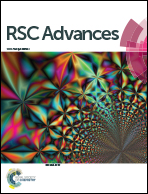Compositional dependence of electrocaloric effect in lead-free (1 − x)Ba(Zr0.2Ti0.8)O3–x(Ba0.7Ca0.3)TiO3 ceramics
Abstract
We studied the electrocaloric effect (ECE) in (1 − x)Ba(Zr0.2Ti0.8)O3–x(Ba0.7Ca0.3)TiO3 (BZT–xBCT) ceramics over a wide composition range (x = 0.3–0.7) using an indirect method based on the thermodynamics Maxwell relations. The maximum adiabatic temperature change ΔT was found to shift from the proximity of Curie temperature to higher temperatures, owing to a synergistic effect of field induced change in the phase transition temperature and alignment and growth of polar nano-regions. Coexistence of positive and negative ECEs were confirmed in BCT-rich compositions (x ≥ 0.5). The abnormal negative ECE is presumably attributed to the rhombohedral to tetragonal transition occurred at relatively low temperatures. The most promising ECE was found in BZT–0.4BCT ceramics, which exhibited a uniform ECE in the temperature range of interest, with a promising ΔT of 0.58 K at ∼125 °C under a moderate electric field of 28 kV cm−1.


 Please wait while we load your content...
Please wait while we load your content...